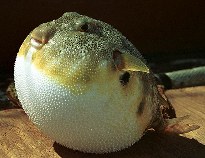Sphoeroides maculatus (Bloch & Schneider, 1801)
Northern puffer
添加你自己的观测位置在 Fish Watcher
| Native range | All suitable habitat | Point map | Year 2050 |

|
| This map was computer-generated and has not yet been reviewed. |
| Sphoeroides maculatus AquaMaps Data sources: GBIF OBIS |
United States (contiguous states) country information
Common names:
Chicken-of-the-sea, Green eye, Northern puffer
Occurrence: native
Salinity: brackish
Abundance: | Ref:
Importance: | Ref:
Aquaculture: | Ref:
Regulations: | Ref:
Uses: no uses
Comments:
National Checklist:
Country Information: https://www.cia.gov/library/publications/resources/the-world-factbook/geos/us.html
National Fisheries Authority: http://www.nmfs.gov
Occurrences: Occurrences Point map
Main Ref: Robins, C.R. and G.C. Ray, 1986
National Database:
Occurrence: native
Salinity: brackish
Abundance: | Ref:
Importance: | Ref:
Aquaculture: | Ref:
Regulations: | Ref:
Uses: no uses
Comments:
National Checklist:
Country Information: https://www.cia.gov/library/publications/resources/the-world-factbook/geos/us.html
National Fisheries Authority: http://www.nmfs.gov
Occurrences: Occurrences Point map
Main Ref: Robins, C.R. and G.C. Ray, 1986
National Database:
Common names from other countries
分类 / Names 俗名 | 同种异名 | Catalog of Fishes(属, 种) | ITIS | CoL | WoRMS | Cloffa
Teleostei > Tetraodontiformes (Puffers and filefishes) > Tetraodontidae (Puffers) > Tetraodontinae
Etymology: Sphoeroides: Greek, sphaira = ball + Greek, suffix, oides = similar to (Ref. 45335).
More on authors: Bloch & Schneider.
Etymology: Sphoeroides: Greek, sphaira = ball + Greek, suffix, oides = similar to (Ref. 45335).
More on authors: Bloch & Schneider.
Environment: milieu / climate zone / depth range / distribution range 生态学
海洋; 半咸淡水 居于水底的; 深度上下限 10 - 183 m (Ref. 5951). 溫帶; 54°N - 29°N
分布 国家 | FAO区域 | 生态系 | 标本纪录 | Point map | 简介 | Faunafri
Western Atlantic: Newfoundland in Canada to northeastern Florida in USA.
西大西洋: 對佛羅里達東北方的加拿大的紐芬蘭。
西大西洋: 對佛羅里達東北方的加拿大的紐芬蘭。
大小 / 重量 / 年龄
Maturity: Lm ? range ? - ? cm
Max length : 36.0 cm TL 雄鱼/尚未辨别雌雄; (Ref. 7251); common length : 20.0 cm TL 雄鱼/尚未辨别雌雄; (Ref. 3821)
Max length : 36.0 cm TL 雄鱼/尚未辨别雌雄; (Ref. 7251); common length : 20.0 cm TL 雄鱼/尚未辨别雌雄; (Ref. 3821)
简单描述 检索表 | 型态特徵 | 形态测量图
背棘 (总数) : 0; 背的软条 (总数) : 8; 臀棘: 0; 臀鳍软条: 7. Upper side grey or brown with poorly defined black spots and saddles. Belly yellow to white. Tiny jet-black pepper spots (about 1 mm in diameter) scattered over most of pigmented surface, particularly evident on cheeks. Lower sides with a row of black, elongate, bar-like markings. No lappets on head or body (Ref 53033).
上侧面灰色的或褐色的有模糊不清的黑色斑点与鞍状斑。 腹面黄色到白色。 极小的墨黑色胡椒粉斑点 (大约 1 mm 直径) 散布在大部分的着色表面, 特别地显著的在颊上。 下侧有一列黑色,延长,像横带一样的斑纹。 没有在头部或身体 (参考文献 53033) 上的垂部.
上侧面灰色的或褐色的有模糊不清的黑色斑点与鞍状斑。 腹面黄色到白色。 极小的墨黑色胡椒粉斑点 (大约 1 mm 直径) 散布在大部分的着色表面, 特别地显著的在颊上。 下侧有一列黑色,延长,像横带一样的斑纹。 没有在头部或身体 (参考文献 53033) 上的垂部.
Inhabits bays, estuaries and protected coastal waters. Sold as `sea squab' in northern part of range. Feeds primarily on shellfish, occasionally on finfish. Reportedly non-toxic.
栖息于海湾,河口与有遮蔽的沿岸水域。 卖作了海洋 squab' 在范围的北部中。 主要吃贝, 偶而吃有鳍的鱼。 据报告非有毒的。
栖息于海湾,河口与有遮蔽的沿岸水域。 卖作了海洋 squab' 在范围的北部中。 主要吃贝, 偶而吃有鳍的鱼。 据报告非有毒的。
Life cycle and mating behavior 成熟度 | 繁殖 | 产卵场 | 卵 | 孕卵数 | 仔鱼
西大西洋: 對佛羅里達東北方的加拿大的紐芬蘭。
主要参考文献
Upload your references | 参考文献 | 合作者 : Matsuura, Keiichi | 合作者
Robins, C.R. and G.C. Ray, 1986. A field guide to Atlantic coast fishes of North America. Houghton Mifflin Company, Boston, U.S.A. 354 p. (Ref. 7251)
对人类的威胁
无害处的
人类利用
渔业: 低经济; 水族馆: 商业性
FAO(渔业: 产生; publication : search) | FishSource | 周边海洋
更多信息
Population dynamics
成长参数
Max. ages / sizes
Length-weight rel.
Length-length rel.
体长-频率
Mass conversion
入添量
丰度
成长参数
Max. ages / sizes
Length-weight rel.
Length-length rel.
体长-频率
Mass conversion
入添量
丰度
Physiology
Body composition
Nutrients
耗氧量
游泳类型
游泳速度
Visual pigments
Fish sound
Diseases & Parasites
Toxicity (LC50s)
Body composition
Nutrients
耗氧量
游泳类型
游泳速度
Visual pigments
Fish sound
Diseases & Parasites
Toxicity (LC50s)
工具
E-book | 野外调查 | 检索表 | 长度- 频率 Wizard | 生活- 历史的工具 | 分布图 | Classification Tree
| Catch-MSY |
特别资料
下载 XML
网络资源
Aquatic Commons | BHL | Cloffa | Websites from users | 核实 FishWatcher | CISTI | Catalog of Fishes(属, 种) | DiscoverLife | ECOTOX | Faunafri | Fishtrace | GenBank(基因组, 核苷酸) | GloBI | GOBASE | | Google Books | Google Scholar | Google | IGFA World Record | MitoFish | Otolith Atlas of Taiwan Fishes | 公众的水族馆 | PubMed | Reef Life Survey | 参考资料的核实 | Scirus | SeaLifeBase | 树状分类阶层 | Wikipedia(转至, 搜寻) | World Records Freshwater Fishing | 动物学的记录
Estimates based on models
Preferred temperature (Ref. 115969): 4.9 - 24.4, mean 9.3 (based on 71 cells).
Phylogenetic diversity index (Ref. 82804): PD50 = 0.5000 [Uniqueness, from 0.5 = low to 2.0 = high].
Bayesian length-weight: a=0.02291 (0.01031 - 0.05092), b=2.89 (2.72 - 3.06), in cm Total Length, based on LWR estimates for this Genus-body shape (Ref. 93245).
营养阶层 (Ref. 69278): 4.0 ±0.66 se; based on food items.
回复力 (Ref. 120179): 高度, 族群倍增时间少于 15个月 (K=0.6).
Fishing Vulnerability (Ref. 59153): Low vulnerability (24 of 100).
Climate Vulnerability (Ref. 125649): Low vulnerability (22 of 100).




